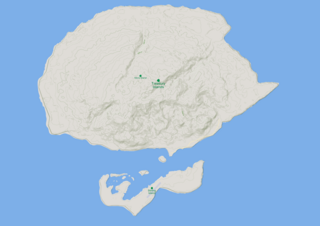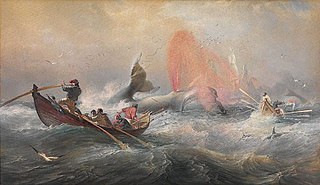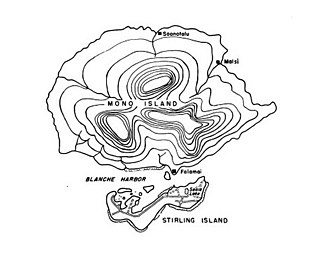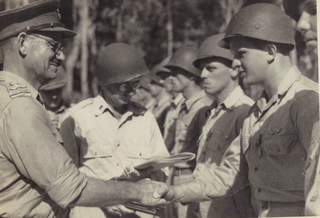
Mono Island is the largest island of the Treasury Islands, Solomon Islands, at 7°21′S155°34′E / 7.350°S 155.567°E .

Mono Island is the largest island of the Treasury Islands, Solomon Islands, at 7°21′S155°34′E / 7.350°S 155.567°E .
Mono island is a volcanic island in the northwest of Solomon Islands. It is separated by the Blanche Harbour from Stirling Island and the other coral islands surrounding it. The village of Falamai is the main population centre of the island. The island is rimmed by limestone cliffs of more than twenty metres in height. The island's population is around 1,800.
The earthquake of April 1, 2007, and the tsunami following the earthquake caused considerable damage in Mono. Five houses and all school buildings collapsed and four people were reported missing.
The island is thought to have been sighted by Bougainville on 28 June 1768. [1]
Mono and Stirling Island were encountered in 1788 by Shortland who named them the Treasury Islands. [2]
Whaling vessels sometimes visited the islands in the nineteenth century. [3]
By the 1880s, the native population of Mono was about 500. [4] Apart from their own language, some spoke Fijian and a little English was also spoken. Many of the men at that time left the island on labour vessels to work on plantations at Fiji and elsewhere in the Pacific.

The Japanese had occupied Mono during their invasion of the Solomons. On October 27, 1943, the 8th Brigade of the Third New Zealand Division and the U.S. 87th Navy Construction Battalion landed at two locations: at Falamai (site of the Japanese HQ on the island) in the south, and at Purple Beach at Soanotalu in the north. By November 7 the island was under Allied control. Twelve Americans and forty New Zealanders were killed during the campaign. For the New Zealanders, it was the first opposed amphibious operation since Gallipoli. [5]
Stirling Island was turned into a huge airstrip by the allies, which was left deserted after the war ended.
Mono Island is a diving paradise and is from time to time a port of call for cruising ships.

The Gilbert Islands are a chain of sixteen atolls and coral islands in the Pacific Ocean, about halfway between Papua New Guinea and Hawaii. They constitute the main part of the nation of Kiribati.

Bougainville Island is the main island of the Autonomous Region of Bougainville, which is part of Papua New Guinea. Its land area is 9,300 km2 (3,600 sq mi). The population of the whole province, including nearby islets such as the Carterets, is approximately 300,000. The highest point is Mount Balbi, on the main island, at 2,715 m (8,907 ft).

Solomon Islands, also known simply as the Solomons, is a country consisting of six major islands and over 900 smaller islands in Melanesia, part of Oceania, to the northeast of Australia. It is directly adjacent to Papua New Guinea to the northwest, Australia to the southwest, New Caledonia and Vanuatu to the southeast, Fiji, Wallis and Futuna, and Tuvalu to the east, and Nauru and the Federated States of Micronesia to the north. It has a total area of 28,896 square kilometres, and a population of 734,887 according to the official estimates for mid 2023. Its capital, Honiara, is located on the largest island, Guadalcanal. The country takes its name from the wider area of the Solomon Islands archipelago, which is a collection of Melanesian islands that also includes the Autonomous Region of Bougainville, but excludes the Santa Cruz Islands.

Western Province is the largest of the nine provinces of Solomon Islands. The area is renowned for its beautiful tropical islands, excellent diving and snorkelling, coral reefs and World War II wrecks, ecotourism lodges, and head-hunting shrines. The province contains many small lagoons and most of the country's tourist trade outside Honiara.
The Shortland Islands is an archipelago of Western Province, Solomon Islands, at 6.92°S 155.88°E. The island group lies in the extreme north-west of the country's territory, close to the south-east edge of Bougainville Island, Papua New Guinea.

Treasury Islands are a small group of islands a few kilometres to the south of Bougainville and 24 kilometres from the Shortland Islands. They form part of the Western Province of the country of Solomon Islands. The two largest islands in the Treasuries are Mono Island and the smaller Stirling Island. The deep water strait between these two islands is called Blanche Harbour.

The Solomon Islands campaign was a major campaign of the Pacific War of World War II. The campaign began with Japanese landings and capture of several areas in the British Solomon Islands and Bougainville, in the Territory of New Guinea, during the first six months of 1942. The Japanese occupied these locations and began the construction of several naval and air bases with the goals of protecting the flank of the Japanese offensive in New Guinea, establishing a security barrier for the major Japanese base at Rabaul on New Britain, and providing bases for interdicting supply lines between the Allied powers of the United States and Australia and New Zealand.

The USS Alnitah (AK-127) was a Crater-class cargo ship in the service of the US Navy in World War II. Named a spelling variation of the star Alnitak in the constellation Orion, it was the only ship of the Navy to bear this name.

The Battle of the Treasury Islands was a Second World War battle that took place between 27 October and 12 November 1943 on the Treasury Islands group, part of the Solomon Islands. The battle formed part of the wider Pacific War and involved New Zealand and US forces fighting against Japanese troops. The majority of the ground forces were provided by the New Zealand 3rd Division.

Nissan Island is the largest of the Green Islands of Papua New Guinea. It is located at 4°30′S154°13′E, about 200 km east of Rabaul on New Britain and about 200 km north-west of Bougainville. The island is administered under Nissan Rural LLG in the Autonomous Region of Bougainville. Nissan island, along with other nearby islands, has been described as a "stepping stone island" and it is believed that this island plays an important role in helping various plant and animal species spread throughout the region.

Whaling in Australian waters began in 1791 when five of the 11 ships in the Third Fleet landed their passengers and freight at Sydney Cove and then left Port Jackson to engage in whaling and seal hunting off the coast of Australia and New Zealand. The two main species hunted by such vessels in the early years were right and sperm whales. Humpback, bowhead and other whale species would later be taken.

Stirling Island is the smaller island of the Treasury Islands,in the nation state of Solomon Islands.
As sealing at Bass Strait and the Antipodes Islands declines, Foveaux Strait becomes the focus for sealers from the middle of the year. The Bounty and Auckland Islands are also visited. Whaling is carried out on the east coast of New Zealand with the Bay of Islands being the usual port of call for provisioning. As many as nine ships whaling together for months at a time can occur. The behaviour of the whalers at the Bay of Islands is again commented on unfavourably, this time by a former missionary on one of the whaling ships. There are also a number of vessels collecting sandalwood from Tonga or Fiji; the majority call at the Bay of Islands en route.
Abraham Bristow (c1771-1846) was a British mariner, sealer and whaler. In August 1806 he discovered the Auckland Islands.
The 36th Battalion was an infantry battalion of the New Zealand Military Forces, which served during the Second World War. Attached to the 8th Brigade, New Zealand 3rd Division, the battalion was formed in late 1941 and saw service in the Pacific against the Japanese. They were initially used for garrison duties on Fiji and Norfolk Island before being committed to the fighting in the Solomon Islands in 1943. The battalion was disbanded in late 1944 as part of a partial demobilisation of New Zealand forces, which saw some of its personnel being returned to civilian employment while others were sent to Italy as reinforcements for the New Zealand 2nd Division.

The 8th Brigade was a formation of the New Zealand Military Forces, which served during the Second World War as part of the 2nd New Zealand Expeditionary Force. Eventually forming part of the 3rd Division, the brigade served in the Pacific Ocean theatre of the war. Raised in late 1940, initially the brigade was employed on garrison duties on Fiji before returning to New Zealand in mid-1942. In December 1942, it was sent to New Caledonia where they remained until early September 1943, when they moved to Guadalcanal to prepare for operations in the Solomon Islands. The brigade's only combat operation of the war came in October–November 1943, when it captured the Treasury Islands. It was disbanded in late 1944 due to manpower shortages in the New Zealand economy.
The 29th Battalion was an infantry battalion of the New Zealand 3rd Division, raised for service during the Second World War. Serving in the Pacific, the battalion mainly undertook garrison duties and labouring tasks in Fiji and New Caledonia, but saw brief combat against the Japanese in the Treasury Islands in late 1943. In late 1944, the battalion returned to New Zealand and was broken up to provide reinforcements for the New Zealand 2nd Division in Italy. It was eventually disbanded in January 1945.
The 34th Battalion was an infantry battalion of the New Zealand Military Forces, which served during the Second World War. Formed in Fiji in late 1940, it saw service in the Pacific against the Japanese.
Rambler was launched in America in 1812. The British captured her in 1813 as she was returning to America from Manila. She then briefly became a West Indiaman. In 1815 she became a whaler in the Southern Fishery. She made four complete whaling voyages and was wrecked on her fifth.
Robert Amos Row, was a senior officer in the New Zealand Military Forces and a two-time recipient of the Distinguished Service Order. He served in the New Zealand Expeditionary Force during the First World War, commanding an infantry battalion. In the Second World War, he commanded the 8th Brigade during the Battle of the Treasury Islands.
This article includes a list of general references, but it lacks sufficient corresponding inline citations .(January 2017) |